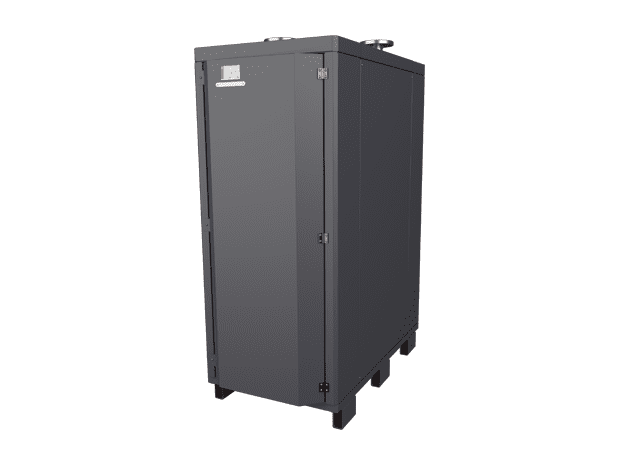During nine weeks in the Spring of 2016 Kensa Heat Pumps completed a compact and challenging heating upgrade programme featuring 11 of the Flagship Group’s properties on an estate in Fressingfield built in 2010. The project showcases the largest number of combinations of communal ground source heat networks installed on one site to date.
The need for a new heating system became apparent when residents of the five year old houses were stung with high energy bills from their inefficient electric panel convector heaters, with one customer reporting bills of £500 a month. Energy for this system could only come from one provider, making switching to reduce bills impossible. “When I moved into the house, I couldn’t believe we had electric panel heaters. I knew these wouldn’t be good for our carbon footprint. So to have a new ground source heat pump is fantastic. It is a major improvement,” commented Mr Blowers, one of the 11 recipients of a new Kensa heat pump.
The housing provider gained unanimous support for its plans at a consultation meeting with residents in January, who all voted for the Kensa Ground Source Heat Pump (GSHP) system.
Matt Smith, Contracts Manager at Flagship Group, said:
We knew we needed to innovate to solve the problem. We had received a petition from customers asking for oil to be installed in their properties, but we are taking steps wherever possible to reduce our reliance on oil in favour of sustainable alternatives. After the consultation meeting, customers all voted in favour of the renewable option.
The 11 properties at Fressingfield features flats, bungalows, semi-detached and detached houses. The diverse make-up of the site demanded an innovative approach to the heating system design with each requiring a bespoke solution for the heat pump, cylinder and radiator location, resulting in five distinct communal ‘heat networks’. The five arrays demonstrate the diverse application of Kensa’s innovative ‘micro district’ approach, which features as few as two properties connected to one communal ground array in order to qualify for the non-domestic Renewable Heat Incentive (RHI: this scheme has now closed – please visit this page to explore other funding) and Energy Company Obligation (ECO) grant funding.
- Array 1: Two boreholes feed one subterranean manifold that supplies heat and hot water to two flats (two storey) and one detached house. The boreholes were drilled in the driveway, with the tarmac reinstated afterwards.
- Arrays 2 & 3: Two pairs of semi-detached houses each fed by one communal borehole. Due to the layout of these property types the pipework from the borehole was cased outside of the gable end of one property and fed through the wall into the first property, and then continued up the wall and through the lofts to feed heat into the neighbouring property.
- Array 4: Two semi-detached houses sharing one borehole. One of the properties did not have enough room to accommodate the ground source heat pump inside, so an external enclosure was custom built to house the unit outside. The second property had a second ‘airing cupboard’ built to house the ground source heat pump internally.
- Array 5: Two bungalows connected to one borehole; the most typical set-up of Kensa’s ‘micro district’ design, which features across the majority of Kensa’s social housing projects.
The geology of the site consisted of Norwich Crag, a notoriously demanding condition which features a sandy formation which can collapse during drilling. To overcome the site conditions Kensa’s drilling contractor, Geo Drill, used a specialist drill rig that cased as it drilled to depths of 140m, ensuring the project kept to schedule and the boreholes integrity was maintained.
Kensa’s unique ‘micro district ground source heat network’ design provides each of the 11 property’s its own 6kW Shoebox ground source heat pump offering heating independence and the freedom to switch energy suppliers, whilst providing efficiencies across the communal heat network and a guaranteed return from the RHI (this scheme has now closed) for the Flagship Group. Flagship will be able to use this income towards lessening its impact on the environment through using more sustainable energy sources in more of its housing stock, which consists of 22,000 homes across the East of England.
Dan Roberts, Project Manager, from Kensa Heat Pumps said:
The variation of property types on this site presented an interesting challenge from a design and delivery point of view as we essentially have four different solutions for 11 properties on one site. However, this gave us the opportunity to demonstrate the flexibility and effectiveness of our systems in a wide variety of applications all in one place. Flagship and their customers were a pleasure to work with and I hope they enjoy their new heating systems.
Rebecca Hazlewood, Flagship’s Sustainability and Wellbeing Team Leader, said:
Our Wellbeing Plan commits us to a continual improvement in our energy use and carbon footprint. This project is a fantastic example of how we can use renewable energy sources to help reduce our carbon footprint, tackle fuel poverty and support the global agreement to achieve net zero emissions by the second half of the century.
One tenant exclaimed, “I can’t wait for winter!”, in reference to the fact that they are looking forward to being warm and also saving money. A neighbour also concurred, “I’m looking forward to getting off the Economy 18 tariff and saving money on my bills.”
It is expected each tenant will save on average £350 a year as a result of their new Kensa ground source heat pump system.
For further details on this project, click here to read the case study in full: https://www.kensaheatpumps.com/case_study/flagship-housing-fressingfield/







